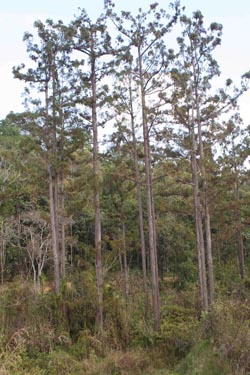Global: Mixed news from the IUCN Red List update
10.11.11
The most comprehensive audit on the state of the planet's wildlife has just received an update. The IUCN Red List of Threatened Species™ has now reviewed more than 61,900 species, and another big step forward has been made toward developing the Red List into a true "Barometer of Life,‟ as called for by leading experts in Science magazine in 2010.
“This update offers both good and bad news on the status of many species around the world,” says Jane Smart, Director, IUCN Global Species Programme. “We have the knowledge that conservation works if executed in a timely manner, yet, without strong political will in combination with targeted efforts and resources, the wonders of nature and the services it provides can be lost forever.”
 As well as worrying movers in the animal world, 25 per cent of all mammals are at risk of extinction, plants remain under-represented on the Red List. Current work underway to increase knowledge includes a review of all Conifers. The results so far uncover some disturbing trends. The Chinese Water Fir (Glyptostrobus pensilis), for example, which was formerly widespread throughout China and Vietnam has moved from Endangered to Critically Endangered. The main cause of decline is the loss of habitat to expanding intensive agriculture and in China there appear to be no wild plants remaining.
As well as worrying movers in the animal world, 25 per cent of all mammals are at risk of extinction, plants remain under-represented on the Red List. Current work underway to increase knowledge includes a review of all Conifers. The results so far uncover some disturbing trends. The Chinese Water Fir (Glyptostrobus pensilis), for example, which was formerly widespread throughout China and Vietnam has moved from Endangered to Critically Endangered. The main cause of decline is the loss of habitat to expanding intensive agriculture and in China there appear to be no wild plants remaining.
Chinese Water Fir (Glyptostrobus pensilis)
© Philip Thomas
A Himalayan yew tree,Taxus contorta, which is used to produce a chemotherapy drug, Taxol, has moved from Vulnerable to Endangered due to over-exploitation for medicinal use and over-collection for fuel wood and fodder. Many other tropical plant species are also at risk. The majority of endemic flowering plants in the granitic Seychelles islands have been assessed and current studies show that of the 79 endemic species, 77 per cent are at risk of extinction. Most of these are new assessments but one species, the infamous Coco de Mer (Lodoicea maldivica) has been uplisted from Vulnerable to Endangered. Known for its giant seed and supposed aphrodisiac properties, the Coco de Mer faces threats from fires and illegal harvesting of its kernels. Presently, all collection and sale of its seed is highly regulated, but there is thought to be a significant black market trade in kernels.
There are worrying trends in the plant kingdom overall. As Dr Tim Entwisle, Director of Conservation at Royal Botanic Gardens, Kew explains: "There are 380,000 species of plants named and described, with about 2,000 being added to the list every year. At Kew we estimate one in five of these are likely to be under threat of extinction right now, before we even factor in the impacts of climate change."
“The IUCN Red List is critical as an indicator of the health of biodiversity, in identifying conservation needs and informing necessary changes in policy and legislation to drive conservation forward,” says Jean-Christophe Vié, Deputy Director of IUCN’s Global Species Programme. “The world is full of marvelous species that are rapidly moving towards becoming things of myth and legend if conservation efforts are not more successfully implemented—if we do not act now, future generations may not know what a Chinese Water Fir or a Bizarre-nosed Chameleon look like.”
Related links:
Over 12,000 plants on the Red List
03.10.09
It’s that dreaded time of year again - the time when it is spelled out so clearly how badly we are failing the planet. The latest update of the IUCN Red List of Threatened Species shows that 17,291 species out of the 47,677 assessed species are threatened with extinction. Of these a staggering 12,151 are plants - up 96 on last year - but it’s almost guaranteed they will get less publicity than their furry friends.
Seychelles: More news from an Island Paradise...
11.11.09
 The Seychelles are a group of 115 islands sheltering in the Indian Ocean. Famous for honeymooners lounging on sandy beaches, they appear a paradise on earth. But beneath the coconut palms you will see people and nature trying hard to get along.
The Seychelles are a group of 115 islands sheltering in the Indian Ocean. Famous for honeymooners lounging on sandy beaches, they appear a paradise on earth. But beneath the coconut palms you will see people and nature trying hard to get along.